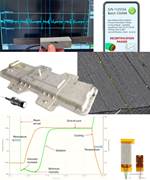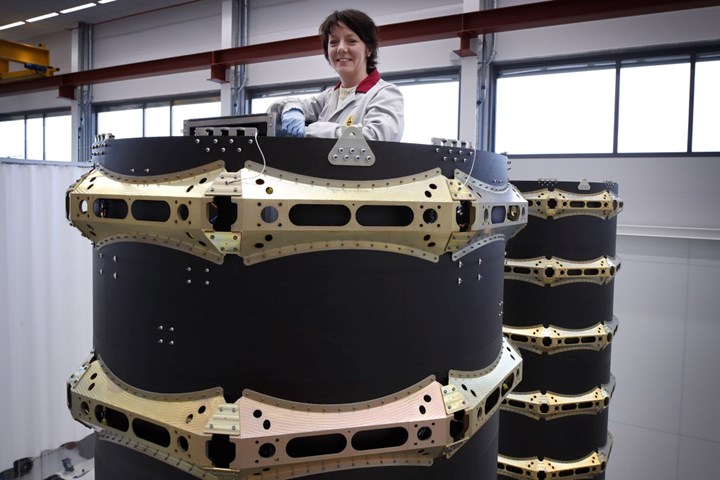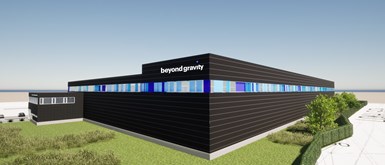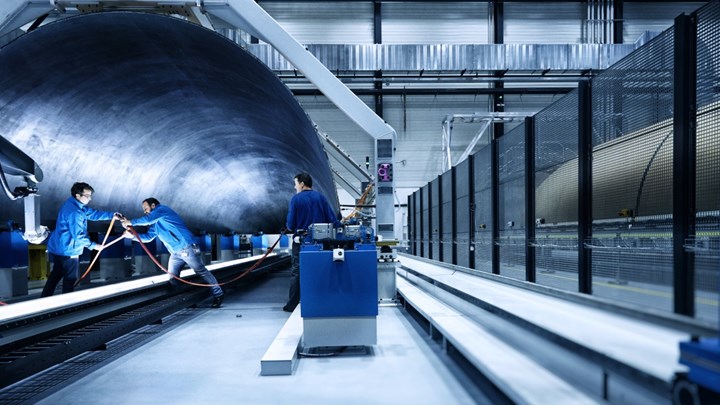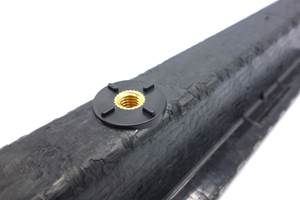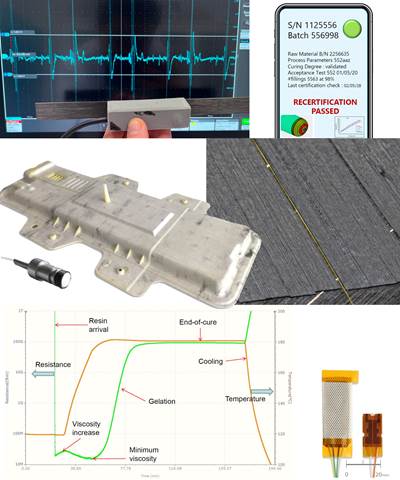RUAG rebrands as Beyond Gravity, boosts CFRP satellite dispenser capacity
NEW smart factory in Linköping will double production and use sensors, data analytics for real-time quality control — CW talks with Holger Wentscher, Beyond Gravity’s head of launcher programs.
RUAG Space is now called Beyond Gravity
RUAG Space, a division of RUAG International, started operating in the market with its new brand Beyond Gravity on March 14, 2022. The company will change its legal name on May 1, 2022. The new name and brand identity will succinctly describe the Space division focus and its value position in the profoundly changing market of New Space, bringing more awareness of its comprehensive range of services to potential customers. Beyond Gravity employs around 1,600 people and is an important global player in the international space market. For more information, visit www.beyondgravity.com.
“We are shortening our production lead times by 50 percent and are thus ideally equipped for industrialized large-scale production.” — Holger Wentscher, VP launcher programs
Doubled capacity for CFRP satellite dispenser systems in Linköping
Beyond Gravity is the world’s leading manufacturer for dispensers used for satellite constellations where multiple satellites of the same design are launched into orbit in quick succession. On March 15, Beyond Gravity broke ground on a new production facility just one kilometer from its existing plant in Linköping, Sweden. Scheduled for completion in 2023, this new facility will double Beyond Gravity’s production capacity — producing one dispenser system every two weeks instead of one every month currently. This expanded capacity will supply the increased volume required to support the growth of large satellite constellations and will increase Beyond Gravity employees in dispenser systems production from roughly 140 to 200 by 2023.
Beyond Gravity has successfully placed more than 1,100 satellites into orbit, including the European Galileo satellite navigation constellation, the OneWeb internet constellation, the TerraBella Earth Observation satellite constellation and the Canadian Radarsat Earth Observation constellation. All Beyond Gravity dispensers and separation systems are manufactured in Linköping, Sweden.
“With smart manufacturing tools and sensors, we will digitize our production line to enable process transparency with real-time data, data analytics and integrated quality control.”
Series production in smart factory
Beyond Gravity (formerly RUAG Space) is ramping up its production of satellite dispensers in Linköping, Sweden with the construction of a new facility, scheduled to be complete by 2023. Photo Credit: © Aspehof Fastigheter, Beyond Gravity.
The new plant in Linköping provides an additional state-of-the-art production area of 4,600 square meters, in addition to the existing production area of 3,000 square meters. The new hall is designed for series production. "We are shortening our production lead times by 50 percent and are thus ideally equipped for industrialized large-scale production," says Holger Wentscher, responsible for the Launchers business at Beyond Gravity. "With smart manufacturing tools and sensors, we will digitize our production line to enable process transparency with real-time data, data analytics and integrated quality control to ensure a high level of performance." To address sustainability, the hall will feature solar panels. “The investment is a clear commitment of us to the Linköping production site. We have excellent employees, great know-how and a perfect infrastructure for New Space."
More than 1,100 satellites placed into orbit
Beyond Gravity's separation systems have been used to perform more than 1,100 in-orbit separations, with a 100% success rate. They are super-lightweight and feature state-of-the-art technology. Built in Linköping for 40 years, they ensure that the satellite and rocket remain securely connected during the tough journey into space, and then precisely deliver the valuable payloads into orbit. At its lower interface the dispenser structure is bolted to the launch vehicle upper stage. Each spacecraft is attached to the dispenser in separation nodes. The Beyond Gravity dispenser system provides a stiff connection in each node during launch, a safe release and an accurate separation provided by the four separation nuts and spring units.
Q&A with Holger Wentscher
Beyond Gravity payload fairings have been successfully used in over 400 rocket launches to date. Its automated OOA process provides significant time and cost savings. Photo Credit: Beyond Gravity
How will the Beyond Gravity rebranding and the new Launchpad incubator affect the use and future vision for composites as well as operations in the U.S.?
We do not see any change in our production processes in the short and medium term. Beyond Gravity will strongly invest in the USA and will significantly grow its number of U.S. employees to serve the highly important and growing U.S. space market. Launchpad will allow promising ideas and concepts to be identified at an early stage as well as their accelerated development.
"Thanks to an innovative process, our payload fairings can be manufactured without the use of an autoclave and thus more effectively."
Will your company’s use of OOA continue, or are there other materials and/or processes being developed?
For our OOA (i.e., oven cure) production in Decatur, Alabama and Emmen, Switzerland, we are upgrading the plants for higher volumes, but there are no technology changes planned for the near future. Part of these production line upgrades, however, include automation to achieve further cycle time reductions. In Linköping, we are introducing a state-of-the-art automated fiber placement (AFP) process for the next generation of dispenser structures. That competency and capacity will subsequently also be adapted for other satellite structure elements.
The ever-increasing demand for shorter development lead time and flexible designs and solutions means that Beyond Gravity has continued to invest in new composites production technologies, with AFP systems as the latest investments.
Which sites use composites and for which types of structures?
Currently at all sites where we produce structures, we perform composites manufacturing processes, with the exception of Titusville, Florida. Beyond Gravity has a long track record in using composites, building mass-optimized products for its satellite central tubes, payload adapters and satellite dispensers. Beyond Gravity is the world's leading supplier of composite technology for payload fairings, including for the European Ariane and Vega launch vehicles, the American Atlas and Vulcan rockets and the Japanese H3. They are built using aluminum honeycomb cores with carbon fiber-reinforced composite cover layers. Beyond Gravity’s offering more recently includes composite interstage and heat shield structures for Vulcan and interstage and payload adapter structures for the SLS (Space Launch System).
How does Beyond Gravity see the New Space market and are there any issues with the current carbon fiber composites supply chain?
New Space is highly important to us and we see a lot of potential business there. We have products that perfectly suit the needs of New Space companies. Beyond Gravity is already a preferred supplier of structures for all types of launch vehicles and a leader in selected satellite products and adapter and dispenser systems for constellations in the New Space sector. The carbon fiber prepreg supply chain is certainly of strategic importance, and we are seriously looking at that.
How does your company view sustainability and recycling?
Sustainability is an important part of our company strategy. Many of our sites in different countries have certified management systems that comply with the international environmental management standard as well as a focus on sustainable energy. We are also developing new sustainable technologies, like using natural fibers (bio-composites) instead of carbon fibers for satellite structures (see “Natural fibres threaded into satellites for safer missions”) and we are further developing 3D printing for space.
Related Content
Biomaterials make strides toward composites sustainability
A compilation of trends in development or application of natural fibers, bio-based resins and more showcases industry players, educational institutes and global projects.
Read MoreRobotized system makes overmolding mobile, flexible
Anybrid’s ROBIN demonstrates inline/offline functionalization of profiles, 3D-printed panels and bio-based materials for more efficient, sustainable composite parts.
Read MoreBcomp ampliTex makes appearance in Cupra EV Cup Bucket seats
The entire Cupra Born VZ line-up features all-natural fiber front seats that highlight functionality, aesthetics and reduced CO2 emissions.
Read MoreNatural fiber composites: Growing to fit sustainability needs
Led by global and industry-wide sustainability goals, commercial interest in flax and hemp fiber-reinforced composites grows into higher-performance, higher-volume applications.
Read MoreRead Next
Discover More About Sensors for Composites Processing
Throughout 2020 and 2021, CW has reported on sensors that can be used to process composites, as well as projects that demonstrate their installation and capabilities. This microsite collates CW’s reporting on sensors to provide, in one place, information about the types of sensors being used in composites.
Read MoreAll-recycled, needle-punched nonwoven CFRP slashes carbon footprint of Formula 2 seat
Dallara and Tenowo collaborate to produce a race-ready Formula 2 seat using recycled carbon fiber, reducing CO2 emissions by 97.5% compared to virgin materials.
Read More“Structured air” TPS safeguards composite structures
Powered by an 85% air/15% pure polyimide aerogel, Blueshift’s novel material system protects structures during transient thermal events from -200°C to beyond 2400°C for rockets, battery boxes and more.
Read More

